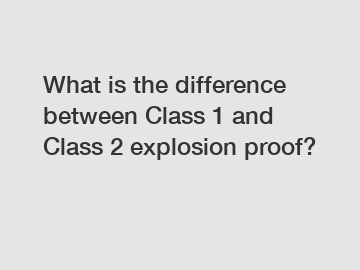Dec. 26, 2023
Lights & Lighting
In industries where hazardous materials exist, safety is paramount. To protect personnel, equipment, and facilities from explosions, explosion-proof electrical equipment is essential. Knowing the differences between Class 1 and Class 2 explosion-proof ratings can help ensure the proper selection and deployment of such devices. In this blog, we will delve into the characteristics, applications, and distinctions between these two classes of explosion-proof equipment, shedding light on the nuances that can make all the difference in ensuring a safe working environment.
Class 1 Explosion-Proof Equipment: .
Class 1 explosion-proof equipment is designed to prevent the ignition of flammable gases, vapors, or liquids. These environments tend to contain highly volatile substances, such as gasoline, solvents, or natural gas. Class 1 equipment is essential for industries like petrochemical refining, oil and gas exploration, and chemical manufacturing.

The primary objective of Class 1 explosion-proof equipment is to contain and extinguish any combustion or explosion within the confines of the device itself. The equipment is constructed using robust materials, such as stainless steel or aluminum, and engineered with principles that prohibit the release of sparks, thermal energy, or external sources capable of igniting the hazardous atmosphere. Additionally, Class 1 devices are designed to withstand high-pressure explosions, minimizing the risk of propagating the explosion to surrounding areas.
Class 2 Explosion-Proof Equipment: .
Class 2 explosion-proof equipment is specifically designed for environments containing combustible dust. These dust particles, when suspended in air and exposed to an ignition source, may cause a hazardous explosion. Examples of industries where Class 2 equipment is essential include grain processing, food manufacturing, pharmaceuticals, and woodworking.
Unlike Class 1 environments, Class 2 hazards are usually caused by the accumulation or presence of combustible dust particles, such as flour, sawdust, or powdered chemicals. Therefore, Class 2 explosion-proof equipment focuses on preventing ignition by ensuring the equipment's internal components are protected against dust ingress, thus eliminating potential ignition sources.
Distinctions between Class 1 and Class 2 Explosion-Proof Ratings:
Now that we have an understanding of each class, let's explore the key differences between Class 1 and Class 2 explosion-proof ratings:
1. Hazard Classification:
Class 1: Flammable gases, vapors, or liquids.
Class 2: Combustible dust particles.
2. Design Construction:
Class 1: Constructed to contain internal explosions and prevent the release of sparks or thermal energy that could ignite flammable gases or vapors in the atmosphere.
Class 2: Designed to prevent dust ingress, ensuring internal components are protected against combustible dust particles that could ignite.
3. Environmental Factors:
Class 1: Gaseous atmospheres with potentially explosive substances.
Class 2: Environments where combustible dust particles are present, either suspended in air or settled on surfaces.
4. Protection Method:
Class 1: Focus on preventing sparks and thermal sources from escaping the equipment.
Class 2: Emphasis on preventing dust ingress, ensuring no internal components can ignite the combustible dust particles.
It is essential to consult with experts and adhere to relevant codes and regulations when selecting explosion-proof equipment, as the distinction between Class 1 and Class 2 environments is crucial to ensuring the appropriate protection level.
Conclusion:
The difference between Class 1 and Class 2 explosion-proof equipment lies in the nature of the hazardous materials present, whether it be flammable gases and vapors, or combustible dust particles. Understanding these distinctions is vital in selecting the right equipment that provides adequate protection against potential ignition sources.
By choosing the correct explosion-proof equipment, industries can create safe work environments for their personnel, protect sensitive equipment from damage, reduce the risk of catastrophic incidents, and maintain compliance with industry safety regulations.
Remember, always consult with subject-matter experts to verify the designated hazard classification and select the appropriate Class 1 or Class 2 explosion-proof equipment for your specific application. Safety is paramount, and arming yourself with the right knowledge ensures a secure and productive work environment for all.
The company is the world’s best ex lighting, explosion proof lighting fixtures, explosion-proof flexible conduit supplier. We are your one-stop shop for all needs. Our staff are highly-specialized and will help you find the product you need.
Previous: What is the price of COB spotlight?
If you are interested in sending in a Guest Blogger Submission,welcome to write for us!
All Comments ( 0 )